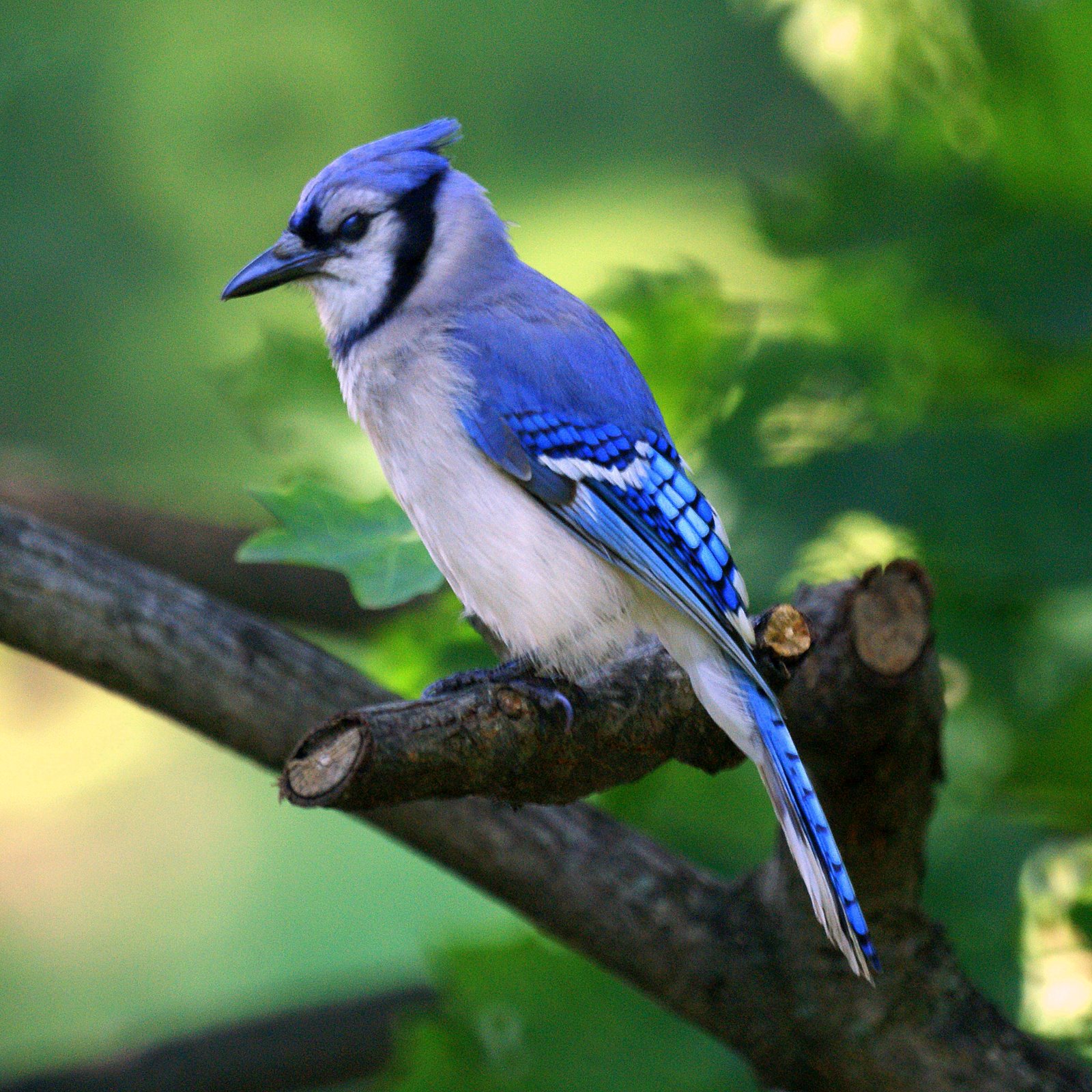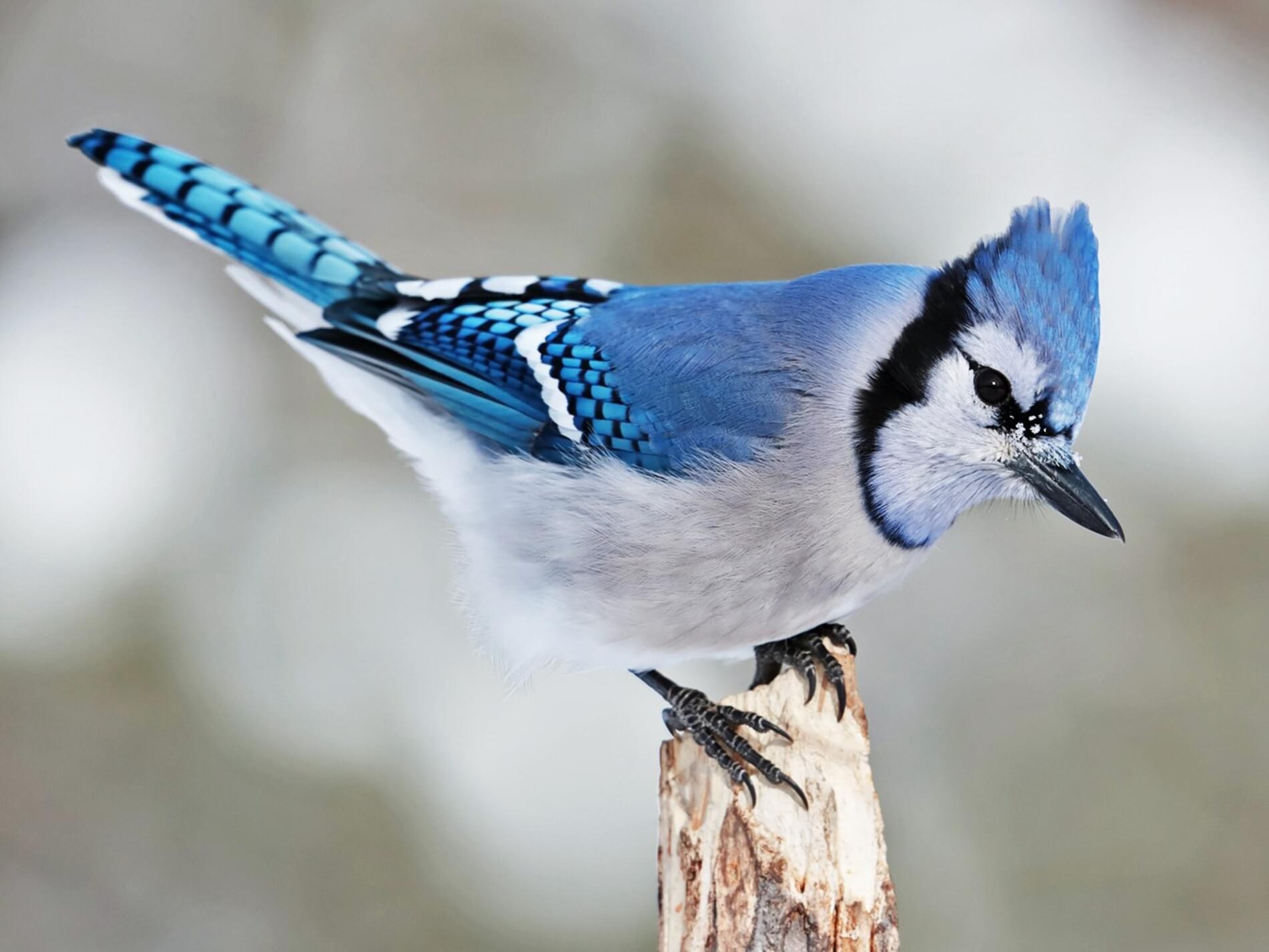Blue Jay Biology and Characteristics

The blue jay, a vibrant and intelligent bird, is a common sight in North American woodlands. These birds are known for their striking plumage, boisterous calls, and complex social interactions. Let’s delve into the fascinating world of blue jays and explore their unique biology and characteristics.
Physical Characteristics
Blue jays are easily recognizable due to their distinctive plumage. Their head, back, wings, and tail are a brilliant blue, often described as a “cobalt blue.” The wings and tail feathers have black borders, creating a striking contrast against the blue. Their underparts are white, and they have a black band across their chest. The blue jay’s beak is stout and black, well-suited for cracking nuts and seeds. They have short, rounded wings, allowing for agile flight, and a long, graduated tail. The average size of a blue jay is about 10-13 inches in length, with a wingspan of 15-18 inches.
Diet and Foraging Habits
Blue jays are omnivorous, meaning they consume a wide variety of food sources. Their diet includes nuts, seeds, fruits, insects, and even small vertebrates. They are opportunistic feeders, taking advantage of available food sources. They are particularly fond of acorns, which they often cache for later consumption. They are also known to raid bird feeders, often stealing food from other birds.
Vocalizations and Communication
Blue jays are known for their loud and varied vocalizations. They have a complex repertoire of calls, including a harsh “jay” call, a scolding “kwee-kwee-kwee” call, and a soft, whistled “whee-whee-whee” call. These calls are used for communication within the flock, as well as for warning others of danger. Blue jays also use mimicry to communicate, imitating the calls of other birds, as well as human sounds.
Breeding Behavior
Blue jays are monogamous birds, forming strong pair bonds. They typically breed in the spring, building their nests in trees or shrubs. The female lays 3-7 eggs, which are incubated for about 18 days. Both parents share the responsibility of feeding and caring for the young. Blue jays are known for their aggressive defense of their nests and young, often attacking predators much larger than themselves.
Blue Jay Ecology and Habitat: Blue Jays
Blue jays, with their vibrant plumage and boisterous calls, are a familiar sight in North American woodlands. These intelligent birds are not only visually striking but also play a crucial role in their ecosystem. Their habitat preferences, interactions with other species, and population dynamics are fascinating aspects of their ecology.
Habitat Preferences
Blue jays are adaptable birds, thriving in a variety of forest types, from deciduous to mixed forests. They are particularly fond of mature forests with a dense canopy, providing ample nesting sites and protection from predators. Their preferred tree species include oak, maple, and pine, which offer abundant food sources. Blue jays can also be found in suburban areas, parks, and even backyards, where they readily exploit human-provided food sources.
Ecological Role
Blue jays are omnivorous, consuming a wide range of food items, including nuts, seeds, fruits, insects, and even small vertebrates. Their diet varies seasonally, with a greater reliance on insects during the breeding season to feed their young.
- Seed Dispersal: Blue jays play a significant role in seed dispersal. They cache nuts and seeds in various locations, often burying them in the ground. This behavior helps to spread seeds to new areas, promoting forest regeneration and biodiversity.
- Insect Control: Blue jays are effective predators of insects, particularly during the breeding season when they require high protein for their chicks. By consuming insects, they help to regulate insect populations and prevent outbreaks.
Interactions with Other Species, Blue jays
Blue jays are known for their territorial nature, often engaging in aggressive displays to defend their nesting sites and food sources. However, they also exhibit cooperative behavior, particularly during the winter months when they form flocks with other bird species, such as chickadees and nuthatches. These mixed flocks provide increased vigilance against predators and facilitate foraging efficiency.
- Competition: Blue jays compete with other birds for food and nesting sites. For example, they may compete with squirrels for acorns and other nuts.
- Cooperation: Blue jays cooperate with other bird species, particularly during the winter months, forming mixed flocks for foraging and predator avoidance.
Population Fluctuations
Blue jay populations are influenced by a variety of factors, including food availability, habitat loss, and climate change.
- Food Availability: Fluctuations in food availability, particularly during the breeding season, can significantly impact blue jay populations. Abundant food resources allow for successful nesting and chick survival.
- Habitat Loss: Habitat loss due to deforestation and urbanization can negatively affect blue jay populations by reducing nesting sites and food sources.
- Climate Change: Climate change can impact blue jay populations through altered weather patterns, changes in food availability, and increased susceptibility to diseases.
Blue Jay Cultural Significance and Human Interaction

The blue jay, with its striking plumage and boisterous calls, has captured the imagination of humans for centuries. It has been woven into folklore, literature, and art, reflecting its prominent role in the natural world and its cultural significance across diverse societies.
Blue Jays in Literature, Folklore, and Art
The blue jay’s presence in literature, folklore, and art showcases its cultural significance.
- In Native American folklore, the blue jay is often portrayed as a trickster figure, known for its intelligence and mischievous nature. For example, in the Cherokee tradition, the blue jay is believed to have stolen fire from the gods, a story that highlights the bird’s cunning and its role in shaping the world.
- In literature, the blue jay has been featured in works by renowned authors like Henry David Thoreau, who described the bird’s vibrant colors and its “loud, harsh cries” in his writings about nature. The blue jay also appears in children’s literature, often symbolizing playfulness and the wonders of the natural world.
- In art, the blue jay has been depicted by artists from various periods and cultures. From the intricate wood carvings of Native American tribes to the detailed paintings of European naturalists, the blue jay’s striking plumage and bold personality have inspired countless artistic creations.
Cultural Significance of Blue Jays
Blue jays hold diverse cultural significance in different societies.
- In some cultures, the blue jay is associated with good luck and prosperity. For example, in certain Native American tribes, the blue jay is believed to bring messages from the spirit world, symbolizing wisdom and guidance.
- In other cultures, the blue jay is seen as a symbol of resilience and adaptability. Its ability to thrive in a variety of habitats and its bold nature are seen as qualities to be admired.
- The blue jay’s loud calls are often associated with warnings or announcements, reflecting its role as a sentinel in the forest. This association with vigilance and communication has led to the blue jay being seen as a symbol of alertness and awareness.
Common Misconceptions and Beliefs
There are several common misconceptions and beliefs about blue jays.
- One misconception is that blue jays are aggressive birds that attack other birds. While blue jays can be territorial and defend their nests, they are generally not aggressive towards other species. They are more likely to engage in competitive behaviors with other blue jays, especially during mating season.
- Another misconception is that blue jays are harmful to other bird species, particularly smaller songbirds. While blue jays may occasionally prey on eggs or nestlings, this behavior is not widespread and does not significantly impact the populations of other bird species.
- Some people believe that blue jays are a sign of bad luck. This belief is likely rooted in the bird’s loud calls, which can be perceived as disruptive or unsettling. However, there is no scientific basis for this belief.
Impact of Human Activities on Blue Jay Populations
Human activities have a significant impact on blue jay populations.
- Habitat loss due to deforestation, urbanization, and agricultural expansion is a major threat to blue jay populations. As forests are cleared, blue jays lose their nesting and foraging grounds, leading to population declines.
- Climate change is also impacting blue jay populations. Rising temperatures and changes in precipitation patterns can disrupt breeding cycles and food availability, making it more difficult for blue jays to survive and reproduce.
- Pollution, including pesticide use and air pollution, can also harm blue jay populations. Pesticides can accumulate in the food chain, leading to health problems and reproductive issues in blue jays. Air pollution can also affect their respiratory systems and overall health.
Blue jays are known for their striking plumage and boisterous calls, but did you know they’re also incredibly intelligent birds? They’ve even been observed using tools to get food! And speaking of intelligence, have you heard of Gavin Sheets , the rising star in baseball?
Just like blue jays, he’s making waves in his field with his sharp skills and impressive performance. It’s amazing how nature and sports can both inspire us with such fascinating feats of intelligence and skill.
Blue jays are known for their vibrant plumage and loud calls, but did you know they also play a role in seed dispersal? These clever birds often cache nuts and seeds, sometimes forgetting where they hid them, leading to the growth of new trees.
This natural process, much like the lasting impact of Brooks Baldwin in his field, is a testament to the intricate connections within our ecosystems.

